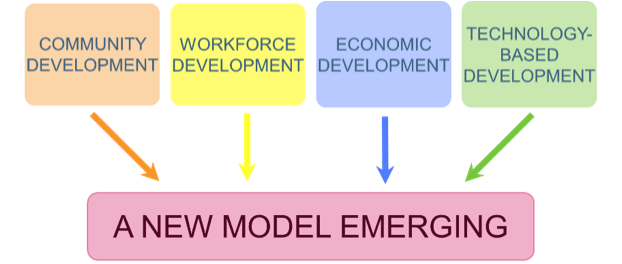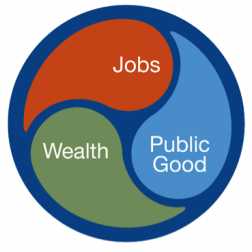A New Model for Public-Private-Philanthropic Engagement

Who will you meet?
Cities are innovating, companies are pivoting, and start-ups are growing. Like you, every urban practitioner has a remarkable story of insight and challenge from the past year.
Meet these peers and discuss the future of cities in the new Meeting of the Minds Executive Cohort Program. Replace boring virtual summits with facilitated, online, small-group discussions where you can make real connections with extraordinary, like-minded people.
Economic. That’s the critical word in this question that leads to disagreement on priorities for investment and action. It’s traditionally outside the domain or on the fringes of our efforts to promote a community’s wellbeing. Housing. Safety. Food/Nutrition. Early Childhood Programs. Training. Health. Environment. In most places, we’ve approached each of these in manners devoid of the business and economic acumen of our cities.
Fortunately that’s changing. Living Cities and Meeting of the Minds are testament to this.
At the same time, our economic development efforts have been mostly dominated by real estate, growth and financial interests focused foremost on wealth development. Our technology-based economic development initiatives keep their eyes on research at the front end and wealth generation on the back. Economic development, then, is most often about wealth for the developers, the financial institutions, the business owners, investors and shareholders and, of course, the tax collector. Smaller efforts may be made toward inclusion and inequities, but these are most often tangential to the core mission.
Fortunately, that’s changing, too.
All four of the verticals encompassing the policies and programs cities invest in to encourage wellbeing and prosperity – community development, workforce development, economic development and tech-based economic development – are converging into a new model for public-private-philanthropic engagement. A model yet to fully emerge.

We have too many statistics to show the current model doesn’t work. If the verticals were designed properly, they would be working themselves out of business. Instead, both the funding sources and the funded organizations are too heavily invested in the structures or ideology that created them. Both sides have apparently forgotten it’s not about them.
Every city has dozens of well-meaning organizations, agencies, institutions, groups and individuals working to create positive change across the four verticals. But as funding tightens and the evidence shows more needs to be done, these structures often try to change what they do without changing what they are – or asking if they should even continue to exist given the scope of the transformational change needed. Our boundaries, bureaucracies, invested interests, and organizational inertia are slowing the emergence of the new path.
As the new model emerges, answers to the opening question are being found by individuals often working around the organizations and policies intended to help them. There is an urgency or impatience that has many traditional programs becoming less and less relevant, despite continued public or philanthropic investment.
To broaden economic opportunity for a city’s residents, we need to reestablish each individual’s sense of belonging and their ability to believe in possibility. These need to happen simultaneously on several scales – the city block, the neighborhood, the community, the region, the world.
 Where this appears to be happening already is around shared, specific problem solving. While traditional economic development has focused on wealth and job creation, the emerging model sees us shifting priorities toward addressing greater public good. As long-term, sustained public good is addressed, prosperity will follow (see the yin-yang-yum diagram at right).
Where this appears to be happening already is around shared, specific problem solving. While traditional economic development has focused on wealth and job creation, the emerging model sees us shifting priorities toward addressing greater public good. As long-term, sustained public good is addressed, prosperity will follow (see the yin-yang-yum diagram at right).
The language and structures of this shift – impact investing, B corps, corporate social responsibility, social entrepreneurship – is already emerging, but is also easily coopted by the goals and structures of players in the four old verticals.
A component of the new model is the emergence of loose affiliations temporarily organized around specific challenges that participants want to address. These efforts can arise from meet-ups leading to new maker places or civic tech accelerators; neighborhood crime block watches spawning parks/playgrounds/community gardens or neighborhood-supported business development.
Traditional organizational hierarchy and positions/titles are often ignored – or tapped only when beneficial to solving the challenge. In many places, technology is allowing us to open up the ability to participate. In others, the lack of technology, or funding, is spurring innovation.
The organic nature of the collective problem solving in the emerging model helps break down the old verticals by focusing initial efforts on outcomes. The old model starts with the institution or organization asking: what tools do we have ready to employ? The old model also asks: what are the impacts of these changes on our organization or existing power/wealth? The new model dismisses these questions outright. It isn’t about us.
During the disruption of the transition period, embracing change means some difficult decisions are made. It also means less top-down and formally directed programs, which seems antithetical to how government, philanthropic, corporate or institutional funding works. Funders need to learn to trust the chaos in the system as the new mindset unfolds based on more adaptive, more dynamic, more complex integration of uncontrolled parts (each solving its own problems).
If we’re starting from a vision of what we want in the long term, rather than what is possible given our current menu of programs and tools; focused on solving the problem; open to including everyone and anyone sharing the vision but not wedded too tightly to a single approach; and helping everyone involved to remember it isn’t about us (or organizations or positions), then we’ll be moving in the right direction to answer that challenge of creating economic opportunity for all.
Discussion
Leave your comment below, or reply to others.
Please note that this comment section is for thoughtful, on-topic discussions. Admin approval is required for all comments. Your comment may be edited if it contains grammatical errors. Low effort, self-promotional, or impolite comments will be deleted.
Read more from MeetingoftheMinds.org
Spotlighting innovations in urban sustainability and connected technology
Middle-Mile Networks: The Middleman of Internet Connectivity
The development of public, open-access middle mile infrastructure can expand internet networks closer to unserved and underserved communities while offering equal opportunity for ISPs to link cost effectively to last mile infrastructure. This strategy would connect more Americans to high-speed internet while also driving down prices by increasing competition among local ISPs.
In addition to potentially helping narrow the digital divide, middle mile infrastructure would also provide backup options for networks if one connection pathway fails, and it would help support regional economic development by connecting businesses.
Wildfire Risk Reduction: Connecting the Dots
One of the most visceral manifestations of the combined problems of urbanization and climate change are the enormous wildfires that engulf areas of the American West. Fire behavior itself is now changing. Over 120 years of well-intentioned fire suppression have created huge reserves of fuel which, when combined with warmer temperatures and drought-dried landscapes, create unstoppable fires that spread with extreme speed, jump fire-breaks, level entire towns, take lives and destroy hundreds of thousands of acres, even in landscapes that are conditioned to employ fire as part of their reproductive cycle.
ARISE-US recently held a very successful symposium, “Wildfire Risk Reduction – Connecting the Dots” for wildfire stakeholders – insurers, US Forest Service, engineers, fire awareness NGOs and others – to discuss the issues and their possible solutions. This article sets out some of the major points to emerge.
Innovating Our Way Out of Crisis
Whether deep freezes in Texas, wildfires in California, hurricanes along the Gulf Coast, or any other calamity, our innovations today will build the reliable, resilient, equitable, and prosperous grid tomorrow. Innovation, in short, combines the dream of what’s possible with the pragmatism of what’s practical. That’s the big-idea, hard-reality approach that helped transform Texas into the world’s energy powerhouse — from oil and gas to zero-emissions wind, sun, and, soon, geothermal.
It’s time to make the production and consumption of energy faster, smarter, cleaner, more resilient, and more efficient. Business leaders, political leaders, the energy sector, and savvy citizens have the power to put investment and practices in place that support a robust energy innovation ecosystem. So, saddle up.






0 Comments